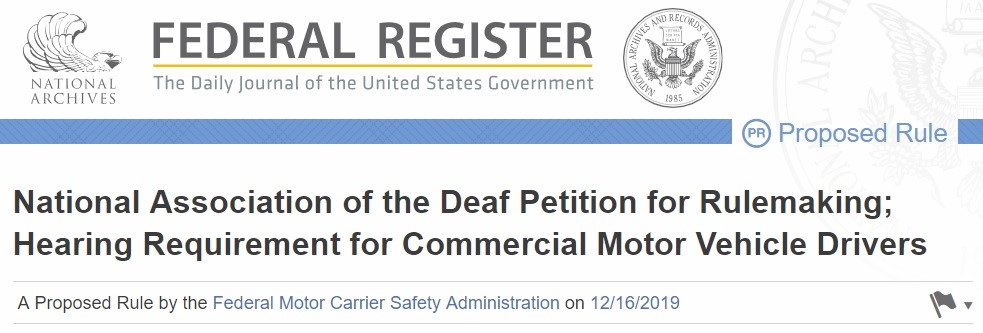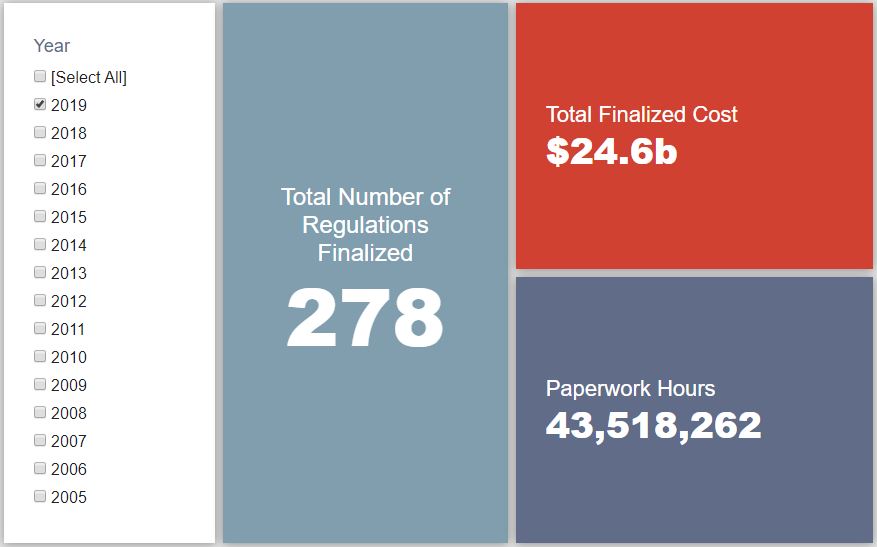Week in Regulation
December 23, 2019
Big Deregulatory Week Swings Regulatory Budget
For the past several weeks, the fiscal year (FY) 2020 regulatory budget under Executive Order (EO) 13,771 has been firmly ensconced in the “regulatory” side of the ledger. That pattern flipped this week. Primarily due to rules from the Department of Labor (DOL) and Environmental Protection Agency (EPA), the net tally of executive agency actions yields nominal cost savings. Across all rulemakings, agencies published $672.9 million in total net cost savings and cut roughly one million hours of annual paperwork.
REGULATORY TOPLINES
- New Proposed Rules: 64
- New Final Rules: 63
- 2019 Total Pages: 70,267
- 2019 Final Rule Costs: $24.6 Billion
- 2019 Proposed Rule Costs: $54.4 Billion
TRACKING THE REGULATORY BUDGET
The most consequential deregulatory measure of the week was EPA’s rule regarding “Accidental Release Prevention Requirements: Risk Management Programs under the Clean Air Act.” This action finalizes revisions to a previous rule that was published in the waning days of the Obama Administration. These amendments remove various compliance requirements from the previous rule. EPA estimates that this change could provide cost savings to affected entities of nearly $617 million (at a 7 percent discount rate). The rule also eliminates 1,071,161 annual hours of paperwork.
The other notable of the week comes from DOL regarding “Regular Rate Under the Fair Labor Standards Act.” This rule updates the regulations regarding how employers calculate the “regular rate” figure that can then be used to calculate an employee’s overtime pay in order “to provide clarity and to better reflect the 21st-century workplace.” DOL estimates that $250 million in net cost savings, primarily from “reduced litigation.”
The Trump Administration expects to reach $51.6 billion in cumulative net savings in FY 2020. To date in the fiscal year, agencies have finalized 34 deregulatory actions and 12 regulatory actions, totaling $21 million in quantified total net savings.
THIS WEEK’S REGULATORY PICTURE
This week, the Department of Transportation (DOT) seeks comment on a petition for rulemaking from the National Association of the Deaf (NAD).

DOT’s Federal Motor Carrier Safety Administration (FMCSA) published a notice in the December 16 Federal Register soliciting input on a petition for rulemaking filed by the NAD in March. The petition asks FMCSA to repeal the current requirement that interstate drivers of commercial motor vehicles be able to hear. It also asks FMCSA to amend requirements that drivers be able to speak – or least broaden the definition of speak to include sign language. Finally, NAD seeks the repeal of a requirement that drivers testing for a commercial license be allowed the use of an interpreter.
Currently, FMCSA grants exemptions to the hearing requirement on a case-by-case basis. NAD says that the three requirements in question are illegal under section 504 of the Rehabilitation Act of 1973, which guarantees certain rights to people with disabilities. Specifically, NAD cites language in the law that “[n]o otherwise qualified individual with a disability…shall, solely by reason of her or his disability, be excluded from the participation in, be denied the benefits of, or be subjected to discrimination under any program or activity receiving Federal financial assistance.”
In addition to its legal objection to the current rules, NAD argues that a shortage of qualified drivers and high unemployment in the deaf community provide a rational basis for amending current regulations. In a nod to the Trump Administration’s regulatory budget, NAD also mentions that the actions would qualify as deregulatory under Executive Order 13,771.
FMCSA notes that it has received feedback in the past from motor carriers and training providers that the behind-the-wheel training required to receive a commercial license could become unsafe if learners are taking their hands off the steering wheel to communicate. Some state licensing bureaus have also expressed that it would be a hardship to provide certified testers with enough knowledge of sign language. FMCSA is accepting comment until February 14, 2020.
TOTAL BURDENS
Since January 1, the federal government has published $79 billion in total net costs (with $24.6 billion in finalized costs) and 57.6 million hours of net annual paperwork burden increases (with 43.5 million coming from final rules). Click here for the latest Reg Rodeo findings.












